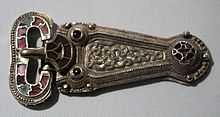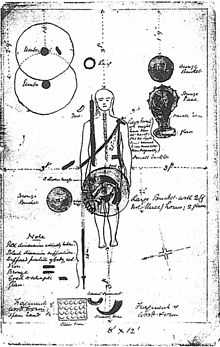Taplow burial
Coordinates: 51°31′52″N 0°41′42″W / 51.5311°N 0.6951°W



The Taplow burial is a 7th-century Anglo-Saxon burial mound in a part of a churchyard at the edge of the small riverside estate of Taplow Court, Buckinghamshire. The burial dates to ca. AD 620, roughly contemporary with the Sutton Hoo burial. The barrow is on a low hill overlooking the Thames Valley.
History
The name Taplow itself is in origin that of the burial mound, from Old English Tæppas hláw "Tæppa's mound", so that the name of the unknown chief or nobleman buried in the mound would seem to have been Tæppa.
The location of the barrow is right at the usual boundary of the kingdoms of Wessex, Sussex, Essex and Mercia during the early (6th century) Anglo-Saxon Heptarchy. As the southern Chilterns region was conquered by Mercia in the early 7th century, the occupant of the barrow at the moment of his death might have been a Kentish sub-king under Mercian dominion.
Taplow hoard
The burial was excavated in 1883 when a hoard of treasures was discovered, on a smaller scale but of similar quality to the Sutton Hoo hoard found in 1939. The "local antiquarians" who excavated the site in 1883 caused a lot of damage to the site and failed to keep a consistent record of their observations.
Artifacts
Among the grave goods, now in the British Museum, were 19 vessels for feasting and drinking, at least three weapon sets, a lyre, a gaming board, and rich textiles, the whole ensemble "recognisably a version of the standard Germanic princely kit". Many of the objects seem to be of Kentish origin. The several gold braids in the burial may have been a symbol of royalty, and the largest horns and the belt buckle were apparently already old when buried, suggesting the treasure of a "Kentish princely family".[1]
All at the British Museum, with several displayed in Room 41:
- Pair of drinking horns
- Gold belt buckle (illustrated above)
- Four glass claw beakers
- Set of gaming pieces
Notes
- ↑ Tyler, 55-56; 56 quoted
See also
References
- Leslie Webster, The Rise, Resuscitation of the Taplow Burial (2001).
- Audrey Meaney, A Gazetteer of Early Anglo-Saxon Burial Sites (1964).
- Michael Lapidge, John Blair, Simon Keynes (eds.), The Blackwell encyclopaedia of Anglo-Saxon England, Wiley-Blackwell (2001), ISBN 978-0-631-22492-1.
- J. Stevens, 'On the remains found in an Anglo-Saxon tumulus at Taplow, Buckinghamshire', Journal of the British Archaeologica Society, 40 (1884), 61-71.
- Tyler, Elizabeth M.,Treasure in the medieval West, 2000, Boydell & Brewer Ltd, ISBN 0-9529734-8-0, ISBN 978-0-9529734-8-5, google books